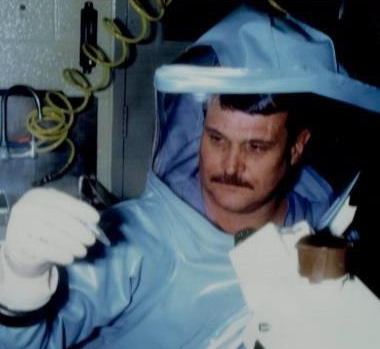Hatfill
Who is Steven Hatfill? The Prospect has spoken with dozens of biowarfare scientists, other government contractors who work in bio-defense, former medical school associates and colleagues, and sources close to the FBI investigation to get a clearer picture of the Maryland scientist.
Hatfill, who was employed as an Ebola researcher at USAMRIID from 1997 to 1999, has since worked as a government contractor who specializes in training U.S. Special Forces, embassy employees, emergency workers, and other government officials to respond to biological attacks. .. his colleagues say he is passionately devoted.
Hatfill had access to the U.S. Army Medical Research Institute for Infectious Diseases (USAMRIID) in Frederick, Maryland, up until early March. As one of a handful of places in the country where scientists grow the most lethal germs in order to develop vaccines to defend against them, USAMRIID and its Utah cousin, Dugway Proving Grounds, have been at the center of the eight-month-old FBI investigation.
Last month, genetic analysis of the letter-anthrax suggested that it was indistinguishable from a strain developed at USAMRIID.
Hatfill belongs to a small pool of people who have access to and detailed knowledge of how to grow and weaponize the highly lethal, concentrated dry powder spores of anthrax that were sent in letters to media personalities and members of Congress last October. Specifically, by virtue of his government contracts,
Hatfill had access to the U.S. Army Medical Research Institute for Infectious Diseases (USAMRIID) in Frederick, Maryland, up until early March. As one of a handful of places in the country where scientists grow the most lethal germs in order to develop vaccines to defend against them, USAMRIID and its Utah cousin, Dugway Proving Grounds, have been at the center of the eight-month-old FBI investigation. Last month, genetic analysis of the letter-anthrax suggested that it was indistinguishable from a strain developed at USAMRIID.
WaPo/Marilyn W. Thompsom, 14 Sep 2003: Stan Bedlington had known (Hatfill) for several years. They were drinking buddies who'd both been involved in anti-terrorism efforts long before the World Trade Center crumbled.
Bedlington, a retired CIA agent, had spent six years as a senior analyst with the CIA Counter-terrorism Center. Hatfill was working as a virology researcher at the U.S. Army Medical Research Institute of Infectious Diseases at Fort Detrick, where he'd begun making a name for himself preaching the dangers of a bioterror attack.
(T)hey ran into each other again at Charley's Place in McLean, then a favorite hangout for the U.S. intelligence community. Agents and officials from the CIA and Pentagon mingled with private consultants and law enforcement agents. Most were cleared to handle classified information, but after long workdays and a few drinks, the conversation often veered to tales of dark intrigue and, occasionally, into drunken bluster.
Hatfill, who first showed up there with men whom Bedlington recognized as bodyguards for Saudi Arabian Prince Bandar bin Sultan, had plenty of stories to tell.
Indeed, several of his associates have told the Prospect that Hatfill bragged of having been a double agent in South Africa.
WaPo: He bragged about being an ex-Green Beret. He walked with a slight limp and told people it was the result of being shot during combat. In a convincing British accent that he could turn on at will, he described parachute jumps and commando training he did under the direction of the British Special Air Service. He detailed his exploits as a member of the Selous Scouts, an elite counterinsurgency unit of Rhodesia's white supremacist army that became notorious for brutality during that country's civil war. He even recounted a devastating outbreak of anthrax poisoning in the Rhodesian bush in the late 1970s, an event later suspected to be part of an effort by the Selous Scouts to control guerrilla uprisings.
Guardian, Jun 2003: The man at the centre of the investigation into the post-9/11 anthrax attacks in the US faked a UK medical degree and membership of the Royal Society of Medicine, to fool his way into a job at America's highest security bio-defence installation.
Dr Steven Jay Hatfill was named last August by US Attorney General John Ashcroft as as the only 'person of interest' in the investigation and now lives under 24-hour surveillance by the FBI. Five people were killed as a result of coming into contact with anthrax spores sent through the post.
Hatfill, a former researcher at the US Army Medical Research Institute of Infectious Diseases at Fort Detrick, Maryland, denies he is the anthrax killer. The US authorities have found no evidence to link Hatfill to the crimes and he has not been charged.
An investigation by the Observer, carried out with with New York-based current affairs magazine Seed, has discovered that the cancer specialist and bio-terror expert claimed he had a medical degree from Edinburgh on CVs used to apply for jobs in the US. He also said he was a Fellow of the prestigious Royal Society of Medicine. The Royal College of Surgeons, Edinburgh had no record of Hatfill qualifying as doctor in 1984, as claimed on his CV. His medical degree is from Zimbabwe, where he qualified in the same year.
Rosamund Snow, RSM spokeswoman, said : 'He is not on our books, nor has he applied to be.'
The investigation found that Hatfill had fabricated large portions of his CV, including claims of serving in the Rhodesian SAS and researching for Nasa's Solar System Exploration Division.
Guardian, Jun 2002: FBI agents investigating the anthrax attacks that killed five people have searched the Maryland home of a former US military scientist who commissioned a study into similar attacks three years ago. The study commissioned by Dr Hatfill describes placing 2.5 grams of bacillus globigii, an anthrax simulant, in a standard business envelope.

